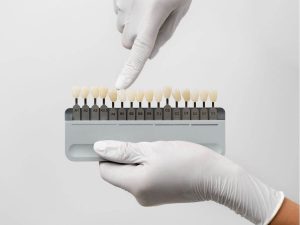
Missing teeth can significantly affect your ability to eat and speak properly. When teeth are lost, the remaining ones may shift into the vacant space, altering your facial structure and jawline.
Additionally, missing teeth can impact your self-esteem. To maintain proper alignment and avoid further complications, it’s crucial to get a suitable replacement for any lost teeth.
Proper replacement teeth not only help preserve your facial shape but also prevent difficulties with eating and speaking. Two popular options for tooth replacement are dental bridges and implants.
A dental bridge effectively fills the gap left by one or more missing teeth.
This dental solution includes two or more crowns that serve as anchors on either side of the gap, known as abutment teeth, along with one or more false teeth called pontics positioned in between.
Pontics can be crafted from various materials such as gold, alloys, porcelain, or a combination of these, ensuring durability and aesthetic appeal.
Dental implants are titanium posts strategically placed into the jawbone below the gum line.
After the implant is securely positioned and the surrounding bone has healed, a replacement tooth is attached to the post.
This implant serves as a durable anchor, ensuring the replacement tooth remains firmly in place.
Dental implants and bridges can both provide natural-looking results, making them popular options for those seeking dental restoration.
Implant treatment typically occurs in two stages to ensure optimal results. First, the implant is placed into your jaw during a local anaesthetic procedure at your dental practice.
It’s crucial to have sufficient bone density for the implant to be securely held in place. If your jawbone lacks adequate volume, your dentist may recommend a bone graft to address this issue.
The second stage involves attaching the crown, which is usually done three to six months after the initial implant placement.
This waiting period allows the bone to heal and integrate with the implant effectively.
For those seeking a quicker solution, some practices offer “smile in a day” treatment, a method for replacing multiple teeth, often referred to as “same day implants”.
Patients may opt for bridges as an alternative because, in certain cases, the procedure is simpler than implants. With bridges, jawbone density isn’t a concern, and fewer dental visits are generally required.
During your initial appointment, the dentist will prepare the adjacent teeth where the bridge will be fitted and take an impression to create a custom mould.
At your follow-up visit, the dentist will secure the bridge in place and ensure your bite feels comfortable—all performed under local anaesthetic for a pain-free experience.
Dental implants can provide longevity similar to natural teeth when properly cared for. In contrast, a dental bridge may weaken over time due to pressure and the alteration of supporting teeth.
Restoration treatment will eventually be necessary for a dental bridge; however, with diligent care, it can be maintained for many years.
Proper maintenance not only extends the life of your dental bridge but also enhances your overall oral health.
When considering dental options, it’s important to understand that a dental bridge is typically more cost-effective than a dental implant.
Bridges often involve a simpler procedure and require fewer visits to the dentist, making them a more accessible choice for many.
In contrast, dental implants generally entail a longer treatment process, including a healing period before the final crown can be placed, leading to more appointments and higher overall costs.
Additionally, implants are crafted from high-quality materials. The titanium implant fixture and abutment provide durability, while the crown, made of ceramic or porcelain, offers a natural appearance.

Here’s a comparison for dental bridge vs implant, highlighting their differences and benefits for those seeking effective dental solutions.

Dental bridges and implants have its advantages, and it’s crucial to select one that meets your needs and boosts your confidence. Timely intervention is key to preventing complications.
At Hello Dental, we prioritise compassionate, personalised care for treatments like dental bridges or dental implants. Our experienced team uses advanced technology to ensure optimal outcomes.
Copyright © 2024 Hello Dental Clinic. All Right Reserved.
475, Jalan Sultan Azlan Shah,
Taman Million,
51200 Kuala Lumpur
Mon-Fri: 09:00-19:00
Sat-Sun: 09:00-17:00
V06-02-05, Signature Retail Lot,
Sunway Velocity,
Lingkaran SV, Jalan Shelley,
55100 Cheras KL
Mon-Fri: 09:30-21:00
Sat-Sun: 09:00-18:00
2-02, Level 2, Wisma Conlay,
No.1, Jalan USJ 10/1,
Taipan Business Centre,
47620 Subang Jaya, Selangor
Mon, Tue, Fri: 10:00-18:30
Wed, Thu: 10:00-21:00
Sat, Sun: 09:00-15:30
G-8, Idaman Robertson,
No. 2, Jalan Robertson,
50150, Kuala Lumpur.
Mon, Thur: 11:00-20:00
Tue, Wed, Fri: 09:30-21:00
Sat, Sun: 10:00-19:00
No. 2-2 (Second Floor),
Jalan Solaris 5,
Solaris Mont Kiara,
50480 Kuala Lumpur
Mon-Fri: 10:00-19:00
Sat-Sun: 10:00-18:00